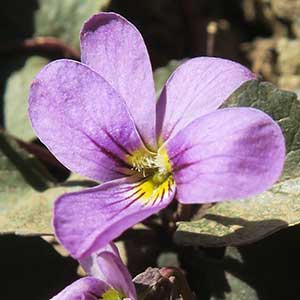Viola flettii
Viola palustris
Flett's violet, Olympic violet, rock violet
alpine marsh violet, marsh violet, northern marsh or marsh or swamp or alpine marsh violet, northern marsh violet, violette des marais
1–3, ascending to erect, mostly glabrous, on caudex from fleshy rhizome.
basal and cauline;
basal: 1–3;
stipules linear-lanceolate, margins entire or with glandular processes, apex acuminate;
petiole 1.5–9.7 cm, mostly glabrous;
blade purple-tinted and –veined, broadly reniform to ovate, 0.9–2.4 × 1.2–4 cm, base cordate, margins finely crenate-serrate, eciliate, apex acute to obtuse, surfaces glabrous or sparsely pubescent along veins adaxially;
cauline similar to basal except: stipules ovate to lanceolate, margins entire or shallowly laciniate;
petiole 0.7–5.9 cm, usually glabrous;
blade 0.8–2.1 × 1.2–3.1 cm.
basal, 2–4, ascending to erect;
stipules linear-lanceolate, margins entire, apex acute;
petiole 1–17 cm, glabrous;
blade unlobed, reniform or ovate to orbiculate, 0.5–6.4 × 0.5–5.5 cm, ± as long as wide, base cordate, margins crenulate, eciliate, apex obtuse to acuminate, surfaces glabrous.
1.8–7.1 cm, usually glabrous.
2–20.7 cm, glabrous, bracteoles usually below middle in chasmogamous flowers.
sepals lanceolate, margins eciliate, auricles 0.5–1.5 mm;
petals soft reddish violet on both surfaces, all with yellow area basally, lower 3 dark violet-veined, lateral 2 bearded, lowest with white around yellow area, 10–15 mm, spur yellow, gibbous, 0.5–2 mm;
style head bearded; cleistogamous flowers axillary.
sepals ovate or lanceolate, margins eciliate, auricles 1–2 mm;
petals lilac, pale blue, or pale violet on both surfaces, sometimes nearly white and tinged with lilac, lowest and sometimes lateral 2 dark violet-veined, lateral 2 bearded or beardless, lowest 8–16 mm, spur usually same color as petals, gibbous, 1–3 mm;
style head beardless; cleistogamous flowers on ascending peduncles.
± spherical, 5–9 mm, glabrous.
ellipsoid, 6–10 mm, glabrous.
dark brown to brownish purple, 2.5–3 mm.
dark brown, 1–2 mm.
= 48.
Viola flettii
Viola palustris
Viola flettii is endemic to the Olympic Mountains of northwestern Washington. C. S. McCreary (2005) noted that although morphologically and ecologically distinct, V. cuneata, V. flettii, and V. ocellata are closely related.
(Discussion copyrighted by Flora of North America; reprinted with permission.)
Viola palustris occurs in small colonies; individual plants are interconnected by stolons. When flowering, usually three or more leaves are present per caudex.
M. Sorsa (1968) noted that in western North America Viola palustris specimens differ from European V. palustris plants and often show variation in character combinations. She stated (pers. comm.) that North American V. palustris is not a uniform entity.
E. Hultén (1968) synonymized Viola palustris with V. epipsila, as did W. J. Cody (2000). G. W. Douglas et al. (1998–2002, vol. 5) recognized both species. We assume that V. palustris does not occur in Alaska; verification is needed. See additional discussion under 18a. V. epipsila var. repens.
M. Sorsa (1968) indicated that Viola palustris var. brevipes has often been confused with V. blanda and that var. brevipes may have arisen from hybridization between a tetraploid and a diploid plant. Listed here in synonymy, var. brevipes may warrant recognition.
Reports of Viola palustris from one location in Coconino County, Arizona, first collected in 1962, likely refer to V. macloskeyi.
Viola palustris hybridizes with V. epipsila var. repens (M. Sorsa 1968; T. Marcussen and T. Karlsson 2010).
(Discussion copyrighted by Flora of North America; reprinted with permission.)
- Local floras:
BC,
CA,
OR,
WA
- Local Web sites:
CalFlora,
CalPhotos,
Flora NW,
Go Botany,
PNW Herbaria,
Turner Photog.
WildflowerSearch
iNaturalist (observations)
USDA Plants Database
- LBJ Wildflower Center
- SEINet
- Plants of the World Online
- Encyclopedia of Life
- Wikipedia
- Google Image Search


